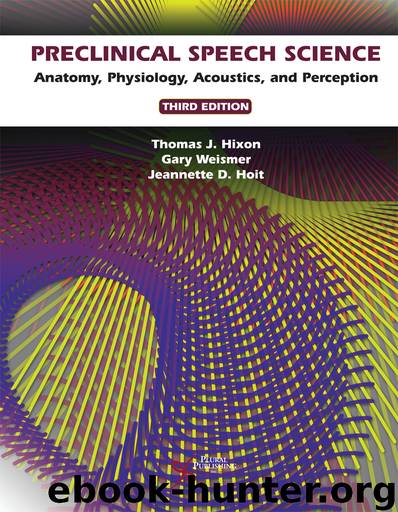Preclinical Speech Science by Hixon Thomas J.;Weismer Gary;Hoit Jeannette D.;

Author:Hixon, Thomas J.;Weismer, Gary;Hoit, Jeannette D.; [Hixon, Thomas J.]
Language: eng
Format: epub
Publisher: Plural Publishing Inc.
Published: 2018-09-02T16:00:00+00:00
Figure 10–9. Spectrogram segmented according to the rules described in the text. The vertical lines immediately below the baseline of the spectrogram show the operationally defined onsets and offsets of the segments, and the phoneme corresponding to a segment is shown between the segment boundaries.
SPEECH ACOUSTICS IS NOT ALL ABOUT SEGMENTS: SUPRASEGMENTALS
A discussion of the techniques of speech acoustic analysis is not complete without mention of phonetic events whose characteristics extend beyond the duration of segments. These events are often called “suprasegmentals” because the pieces over which acoustic analysis is performed are longer than the duration of segment-sized events. Some authors refer to suprasegmental variables as prosodic variables.
A well-known example of a suprasegmental is the fundamental frequency (F0) contour, the variation in F0 over several segments and even across sentence-level utterances. To obtain an F0 contour, the periods of many cycles of vocal fold vibration are measured. In Figure 10–10, the segmented utterance of Figure 10–9 provides an example of an F0 contour analysis. One way to obtain the F0 contour is to measure each of the periods, convert each to F0 by F0 = 1 /T, and graph the resulting values as a function of time. With a proper display of a speech waveform, this is an easy measurement task, but incredibly tedious. One of the authors, who performed this kind of hand analysis before the availability of speech analysis software, did a period-by-period measurement of the utterance in Figure 10–10 and completed it in about 40 minutes.
It is preferable to have an automated procedure to measure F0. Most computer programs designed for speech acoustic analysis, like TF32 or Praat, include algorithms for measurement and display of F0 contours. Scientists typically refer to these algorithms as pitch trackers, even though the name is a technical misnomer because pitch is a perceptual phenomenon and F0 is a physical event (see Chapter 14 for information on the relationship between F0 and pitch). There are many different algorithms for the measurement of F0, each using somewhat different strategies and computations, but ultimately all perform the analysis by measuring the period of each glottal cycle. Above the spectrogram in Figure 10–10 is the F0 contour for “The blue spot is a normal dot,” spoken with a small degree of emphasis on the word “normal.” The F0 contour was computed automatically by TF32 (“automatically” means selecting a command such as “perform pitch analysis”) and is shown exactly as it was computed on a frequency scale of 75 to 200 Hz. Values are computed for each glottal pulse, and typically are not computed where there are no glottal pulses, although there are exceptions to both statements. For example, there are no values computed for the voiceless /s/ in spot (except for two at the end of the frication energy), which makes sense because of the absence of a periodic waveform for the voiceless fricative. However, a couple of values were computed during the /t/ closure interval of the utterance-final word dot. More surprising, perhaps, is:
Download
This site does not store any files on its server. We only index and link to content provided by other sites. Please contact the content providers to delete copyright contents if any and email us, we'll remove relevant links or contents immediately.
Dynamic Alignment Through Imagery by Eric Franklin(4050)
Body Love by Kelly LeVeque(2985)
Barron's AP Calculus by David Bock(1751)
EMT Exam For Dummies with Online Practice by Arthur Hsieh(1631)
The Juice Lady's Remedies for Asthma and Allergies by Cherie Calbom(1538)
Fitness Walking For Dummies by Liz Neporent(1488)
Extremes: Life, Death and the Limits of the Human Body by Fong Kevin(1458)
Flight by Elephant(1457)
McGraw-Hill Nurses Drug Handbook by Patricia Schull(1416)
The Natural First Aid Handbook by Brigitte Mars(1354)
Skin by Unknown(1337)
Tell by Major Margaret Witt(1333)
Seeing Voices by Oliver Sacks(1310)
Born to Walk by James Earls(1262)
Cracking the Nursing Interview by Jim Keogh(1234)
The Yoga Bible by Christina Brown(1219)
First Aid for Colleges and Universities (10th Edition) by Mistovich Joseph J. & Limmer Daniel J. & Karren Keith J. & Hafen Brent Q(1211)
The Advantage by Lencioni Patrick M(1131)
Living Ready Pocket Manual - First Aid: Fundamentals for Survival by James Hubbard(1115)
